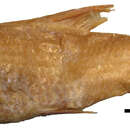Diagnostic Description
provided by Fishbase
Lateral line with 32 to 38 scales, usually 14 to 16 scales around the least circumference of the caudal peduncle; last unbranched ray of dorsal fin markedly longer than head; mouth narrow, lower lip spatulate and median lobe present; and two pairs of barbels (Ref. 94477).
Morphology
provided by Fishbase
Dorsal soft rays (total): 13 - 14; Analsoft rays: 9
Biology
provided by Fishbase
Occurs in fast-flowing reaches of rivers and feeds on small animals (Ref. 94477).
Kosswigobarbus kosswigi: Brief Summary
provided by wikipedia EN
The kisslip himri or Kosswig's barb (Carasobarbus kosswigi) is a species of cyprinid fish of the genus Carasobarbus that is found in the Tigris-Euphrates river system in Iran and Turkey. It was originally described as Cyclocheilichthys kosswigi.
- license
- cc-by-sa-3.0
- copyright
- Wikipedia authors and editors
Description
provided by Zookeys
Body moderately high, laterally compressed and without a nuchal hump. The greatest body depth is at the point of the origin of the dorsal fin. The ventral profile of the head is straight, its dorsal profile has a slight to pronounced hump near the nostrils (Figs 21, 22). The head is short and narrow. The mouth is inferior. The maximum body depth is bigger than the head length (Fig. 12). The lips are comparatively thick and the lower jaw is narrow with a sharp horny sheath and a median lobe. The two pairs of barbels (Table 2) are stout and the anterior pair is quite long. The eyes are rather high in the middle of the head and rather small. The morphometric characters are summarised in Table 1.
The dorsal fin is long and usually has four unbranched and nine or 10 branched rays (Table 3). The last unbranched ray is long and well ossified; only the tip is flexible. It is considerably longer than the head (Fig. 4). The anal fin usually has three unbranched rays and six branched rays (Table 4). Its base is long. The bases of the dorsal and anal fin have a sheath of scales.
There are 32 to 38 scales in the lateral line (Table 5), 5.5 to seven scales above the lateral line (Table 6), 4.5 to 6.5 scales below the lateral line (Table 7) and (12) 14 to 16 scales around the least circumference of the caudal peduncle (Table 8). The scales are shown in Fig. 5.
The pharyngeal teeth count is 2.3.5-5.3.2 in seven specimens, 2.3.5- in one specimen and -4.3.2 in one specimen. The pharyngeal teeth are hooked at their tips (Fig. 6).
Live specimens are silvery. The back is darker than the belly, which is almost white (Fig. 22). Fixed specimens are yellow-brown and some have a darker back.
Carasobarbus kosswigi differs from all congeners, except Carasobarbus sublimus, by having a spatulate lower jaw with a median lobe on the lower lip vs. a crescent-shaped lower jaw and a lower lip without median lobe. It differs from Carasobarbus sublimus by having 32 to 38 scales in the lateral line vs. 27 to 29 and modally 14 scales around the least circumference of the caudal peduncle vs. 12 and by having a longer and more ossified last unbranched ray in the dorsal fin.
- license
- cc-by-3.0
- copyright
- Kai Borkenhagen, Friedhelm Krupp
- bibliographic citation
- Borkenhagen K, Krupp F (2013) Taxonomic revision of the genus Carasobarbus Karaman, 1971 (Actinopterygii, Cyprinidae) ZooKeys 339: 1–53
- author
- Kai Borkenhagen
- author
- Friedhelm Krupp
Distribution
provided by Zookeys
Carasobarbus kosswigi occurs in the Euphrates-Tigris system (Fig. 7).
- license
- cc-by-3.0
- copyright
- Kai Borkenhagen, Friedhelm Krupp
- bibliographic citation
- Borkenhagen K, Krupp F (2013) Taxonomic revision of the genus Carasobarbus Karaman, 1971 (Actinopterygii, Cyprinidae) ZooKeys 339: 1–53
- author
- Kai Borkenhagen
- author
- Friedhelm Krupp

